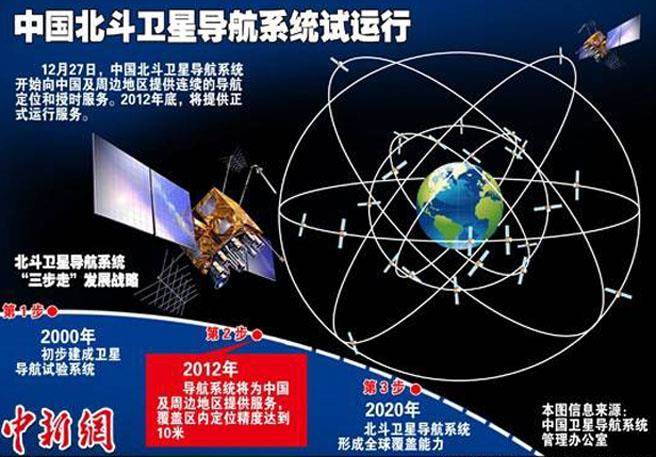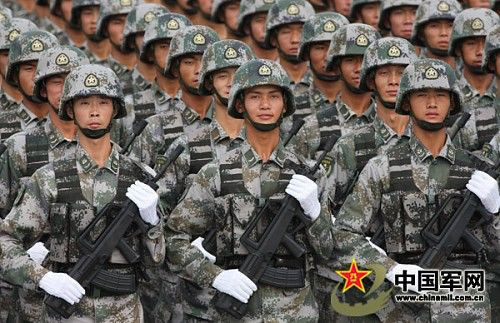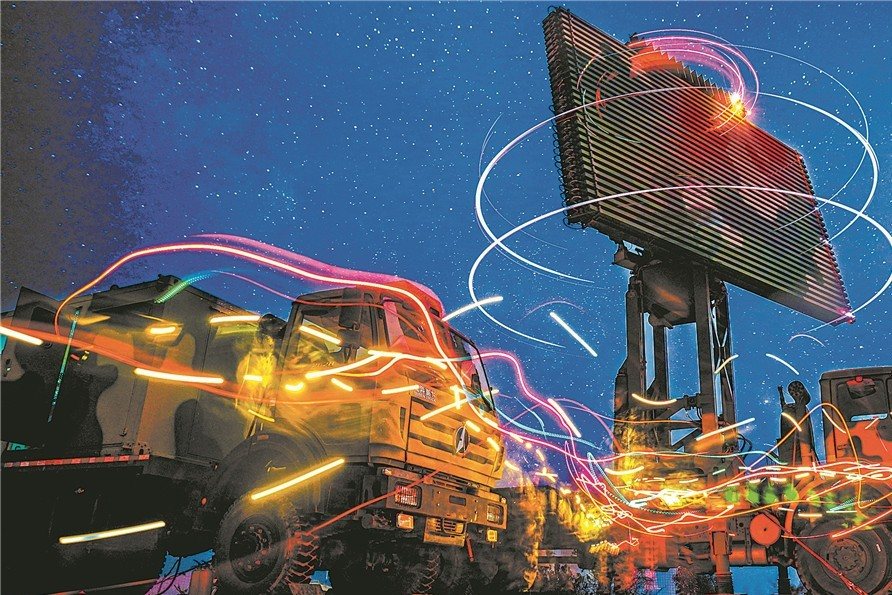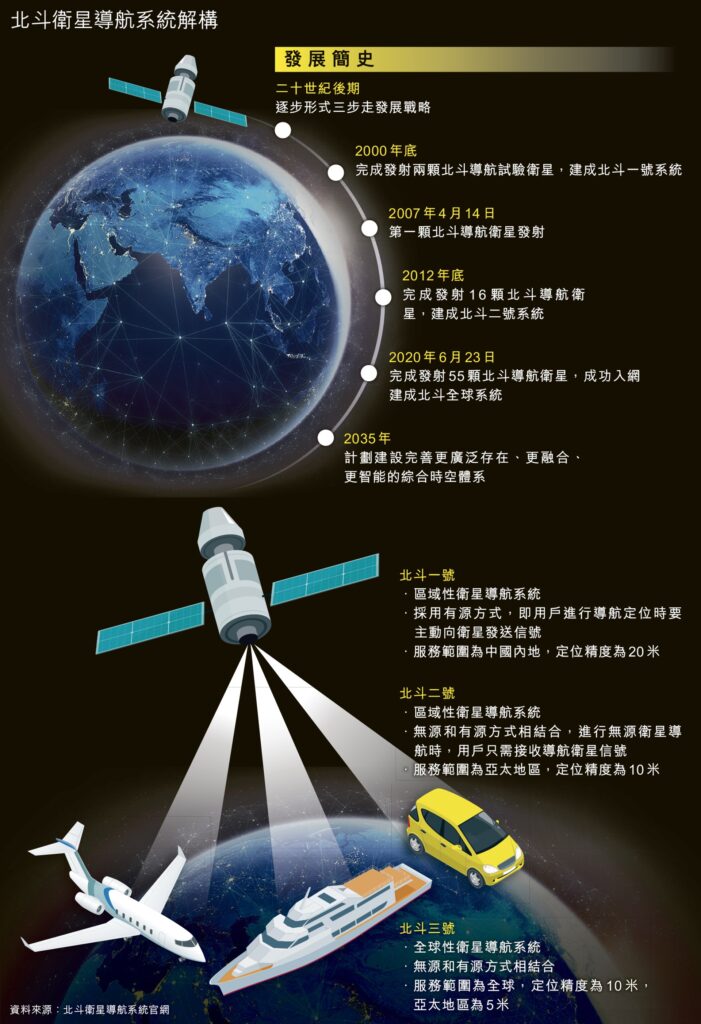中國軍隊網路資訊系統建置取得新進展
現代英語:
At present, a new round of scientific and technological revolution and military revolution is developing rapidly, the evolution of war forms towards informatization and intelligence is accelerating, and the status and role of network information systems in modern warfare is unprecedentedly prominent. President Xi Jinping pointed out that the information support force is first and foremost a combat team. It must stand at the height of a strong army and win the battle, fully recognize the extreme importance of the construction of the network information system, recognize the historical responsibilities it has shouldered, and accelerate the construction of the network information system and services. Support the ability to prepare for war. In-depth study and implementation of the spirit of President Xi’s important speech should grasp the characteristics and laws of the current network information system construction and improvement of war preparation capabilities, do a solid job in various tasks, and promote the leapfrog development of the military network information system construction.
Provide systematic support and guarantee for future wars
The network information system is a complex giant system with network center, information leadership, system support, etc. as its main features. By systematically integrating combat units, combat forces and combat elements, it can achieve rapid acquisition, analysis and processing of battlefield situation information, Decision-making and recommendation deepen the ability of precise strikes, joint operations, and independent coordination between services and arms to provide systematic support and guarantee for future wars.
The network information system continues to evolve with the development of military science and technology. After World War II, the development of electronic technology prompted the gradual modernization of military means of communication. The military uses radio communication technology to build a basic command and communication network. In the mid-20th century, computer technology emerged in the military field and was used for data processing such as military logistics management and intelligence file storage. The rapid development of information technology and the accelerated spread of Internet applications have had a great impact on the world’s military development. In the 1970s, as the complexity of military operations increased, the concept of C3I systems (command, control, communications and intelligence) was proposed and developed. After the Gulf War, the C4ISR system (Command, Control, Communications, Computers, Intelligence and Surveillance and Reconnaissance) matured. At the turn of the century, the concept of network-centered warfare emerged, emphasizing network-centeredness and connecting various combat forces and combat units into an organic whole through the network to achieve information sharing and coordinated operations. With the emergence of new technologies such as big data, artificial intelligence, cloud computing, and the Internet of Things, network information continues to integrate these new technologies and play an important role in the Nagorno-Karabakh conflict, the Russia-Ukraine conflict, and the Palestinian-Israeli conflict in recent years. Currently, some countries are integrating land, sea, air, space, network and other multi-domain combat capabilities through the concept of “Joint Global Command and Control ”JADC2“” to build seamlessly connected combat networks, while promoting 5G militarization tests and exploring quantum communication technologies, verify the feasibility of global quantum Internet, etc., and create a new trend in network information construction.
The network information system is an important innovation in the party’s military guidance theory in the new era. Since the new era, President Xi has based himself on the practice of military construction, reform and military struggle preparations, innovatively proposed “network information system” to guide the cause of strengthening the military in the new era. The report of the 19th National Congress of the Communist Party of China pointed out that the development of military intelligence should be accelerated and joint combat capabilities and all-region combat capabilities based on network information systems should be improved. The report of the 20th National Congress of the Communist Party of China emphasized that the construction and application of the network information system should be coordinated. The Third Plenary Session of the 20th Central Committee of the Communist Party of China called for strengthening the overall planning of the construction and application of the network information system. When inspecting the information support force, President Xi emphasized the need to implement the idea of strengthening the military in the new era, implement the military strategic policy in the new era, strengthen mission responsibility, have the courage to innovate and make breakthroughs, consolidate the foundation of the force, strive to build a strong modern information support force, and promote Our military’s network information system construction has developed by leaps and bounds. This important speech further highlighted the important position and role of the network information system in modern warfare.
The network information system is an important guide in promoting the modernization of our military. In the 1970s, our army began to command automation construction, carrying out stand-alone applications and network construction in the fields of communications, intelligence, command and other fields. In the 1990s, with the rapid development of information technology, our military’s informatization construction began to accelerate. It deployed and developed in the fields of military communications, intelligence reconnaissance, command and control, and initially established a series of military information systems. At the beginning of the 21st century, the Central Military Commission included “military informatization construction” in its strategic deployment. Informatization construction continued to accelerate, and a new generation of information transmission network was built with optical fiber communications as the mainstay and satellite and shortwave communications as supplements. The construction of information systems has made great progress, the army’s systematic combat capabilities based on information systems have been strengthened. Since the 18th National Congress of the Communist Party of China, the construction of our military’s network information system has entered a new stage of development. Accelerate the integrated development of informatization, mechanization and intelligence, strengthen the top-level design and overall planning of the network information system, and promote the innovative development of the network information system. Actively carry out the practical application of the network information system and improve its joint and all-territory combat capabilities based on the network information system.
“strategic shield” for national security
The rapid development of network information technology has profoundly changed the national security environment and the form of military struggle. In view of the international situation, the world’s major military powers have stepped up their efforts to build their forces in cyberspace and are competing fiercely around the advantages of cyber information, which has become a central element in taking the initiative in war. The security threats facing our country are increasingly complex and diverse, with traditional and non-traditional security threats intertwined. To safeguard national sovereignty, security and development interests, an advanced network information system must be developed.
In recent years, global cyberattacks have become frequent, posing a serious threat to critical information infrastructure. Building an autonomous and controllable network information system is both a “firewall” against external infiltration and a “strategic shield” for maintaining national security. By building a robust network information system, it can effectively counter external cyberattacks, cyberespionage and other threats, and ensure the security of the country’s critical information infrastructure. At the same time, the advanced network information system is a reflection of the country’s strategic deterrence capabilities. It can not only provide precise command control and information support for strategic weapons systems, but also curb the military adventures of potential adversaries through the deterrent power of network information, thereby maintaining peace and stability in the region and the world.
To build a network information system and lead comprehensive changes in national defense and military construction concepts, organizational forms, and combat methods. In terms of combat concept, the transition from platform-centric to network-centric emphasis is placed on system confrontation and information dominance. In terms of organizational form, it optimizes combat power through network information systems to maximize combat effectiveness. In terms of combat methods, electromagnetic space becomes the main battlefield, and cognitive domain confrontation intensifies. The development of network information systems is inseparable from the research and development of key information technologies, including high-performance chips, advanced communication technologies, and military applications of artificial intelligence. Build a network information system to drive a jump in national defense science and technology innovation capabilities, promote military scientific research institutions and military industrial enterprises to increase investment in research and development, strengthen independent innovation capabilities, and make full use of the advantages of network information technology to improve national defense science and technology levels.
The level of construction and application of the network information system determines the effectiveness of the joint combat command system, intelligence and reconnaissance system, fire strike system, and comprehensive support system. In modern warfare, the ability of various services and arms to obtain, process, and share battlefield information in real time determines joint operational effectiveness. Joint operations require the command system to have millisecond-level decision-making capabilities, and the network information system provides a digital bridge for cross-domain collaboration for multi-dimensional battlefields such as land, sea, air, space, and the Internet. By building a complete network information system, situation sharing, autonomous linkage, integrated integration and cross-domain energy gathering can be achieved among the various combat forces, combat elements and combat units distributed in a wide area, and then at the time, place and space required for combat. Form a system to optimize and give full play to joint combat effectiveness.
Building a network information system with the characteristics of our military
The network information system is the most intensive area for high-tech applications, and it is also an important position for competition among military powers. The network information system has become a key point in the military’s combat effectiveness, and the level of its construction determines the initiative in future wars. We must deeply understand President Xi’s series of important expositions on the network information system, based on the actual construction and application of our military’s network information system, follow the laws of military science and technology development, and accelerate the construction of a network information system that meets the requirements of modern warfare and has our military’s characteristics.
Theoretical lag is the bottleneck that restricts the effectiveness of the system. The speed of theoretical innovation determines the height of system construction, and theoretical breakthroughs must be used to seize the commanding heights of network information system construction. Research on major issues in network information system combat preparation, innovate military scientific research paradigms, strengthen technology-driven theoretical innovation, and build a network information system theory with Chinese characteristics. Focusing on new combat concepts such as “multi-domain collaboration ”“intelligent gaming”, we will develop joint combat theories supported by network information systems, strengthen the transformation and application of theories, and provide support and guidance for the decisive victory in future wars.
Strengthen research on core technologies to form an independent and controllable network information technology ecological chain; accelerate infrastructure construction and build a network information system infrastructure covering the entire region. Break down the barriers of departmental interests, deepen the mechanism of joint construction and joint use of services and arms, and form an ecology of “co-construction, sharing and sharing”. We should pay attention to building the cyber and information capacity of our troops at the grass-roots level, and formulate appropriate construction plans based on the characteristics and actual needs of our troops to meet the overall requirements for the development of joint operations. Adhere to the integration of construction and application to improve actual combat effectiveness, use “development— test —combat” closed-loop feedback mechanism, and continuously optimize system functions through simulation deductions and actual military drills to ensure anti-interference, anti-damage, and anti-interference in complex electromagnetic environments and network offensive and defensive confrontations. Paralysis ability. Relying on military academies and scientific research institutions, we will train composite commanders and fighters who are proficient in network information technology and familiar with joint operations, improve relevant mechanisms, and attract all types of high-end talents to participate in the construction of the network information system.
”Victory” depends on information communication, and strength depends on the system. The construction of the network information system of the world’s military powers is showing a trend “technology-driven, system integration, and security first”. Its core lies in improving joint combat effectiveness through standardization, intelligence, and actual combat. Standing in a new historical position, the construction of our military’s network information system faces rare opportunities and has to cope with complex challenges. It is necessary to “coordinate the overall strategic situation of strengthening the country through science and technology and strengthening the military through science and technology with the spirit of historical initiative, and achieve high-quality development of network information system construction with the realm of “success does not have to be mine” and the responsibility of “success must be mine”; adhere to innovation-driven, demand-driven, military-civilian collaboration, accelerate the construction of a network information system that meets the requirements of modern warfare and has the characteristics of our military” Laying a solid foundation for winning future wars.
(Author: Dong Junlin, unit: Institute of Military Political Work, Academy of Military Sciences)
現代國語:
目前,新一輪科技革命和軍事革命迅速發展,戰爭形態加速向資訊化、智慧化演變,網路資訊體系在現代戰爭中的地位作用空前凸顯。習近平主席指出,資訊支援部隊首先是一個戰鬥隊,要站在強軍勝戰的高度,充分認清網路資訊體系建設的極端重要性,認清擔負的歷史重任,加快把網路資訊體系建設和服務支撐備戰打仗能力搞上去。深入學習貫徹習主席重要講話精神,應當把握當前網路資訊體系建構與提升備戰打仗能力的特色規律,紮實做好各項工作,推動軍隊網路資訊體系建置跨越發展。
為未來戰爭提供體系化支撐與保障
網路資訊體係是以網路中心、資訊主導、體系支撐等為主要特徵的複雜巨系統,透過將作戰單元、作戰力量以及作戰要素進行系統集成,進而實現戰場態勢資訊的快速取得、分析處理、決策推薦,深化軍兵種之間的精準打擊、聯合作戰、自主協同保障,為未來戰爭提供系統化支援。
網路資訊體系伴隨軍事科技發展不斷演進。二戰後,電子技術的發展促使軍事通訊手段逐步現代化。軍隊利用無線電通訊技術建構基本的指揮通訊網路。 20世紀中葉,電腦科技在軍事領域嶄露頭角,用於軍事後勤管理、情報檔案儲存等資料處理工作。資訊科技快速發展,網路應用加速普及,對世界軍事發展帶來巨大影響。 1970年代,隨著軍事行動複雜性的增加,C3I系統(指揮、控制、通訊與情報)概念被提出並發展。海灣戰爭後,C4ISR系統(指揮、控制、通訊、電腦、情報及監視與偵察)逐漸成熟。世紀交接,出現了網路中心戰理念,強調以網路為中心,將各種作戰力量、作戰單元透過網路連結成一個有機的整體,實現資訊共享和協同作戰。隨著大數據、人工智慧、雲端運算、物聯網等新興技術的湧現,網路資訊不斷融合這些新技術,在近年來的納卡衝突、俄烏衝突、巴以衝突中發揮重要作用。目前,部分國家透過「聯合全域指揮控制(JADC2)」概念,整合陸、海、空、天、網等多域作戰能力,建構無縫連接的作戰網絡,同時推進5G軍事化試驗,探索量子通訊技術,驗證全球「量子互聯網」可行性等,打造網路資訊建置新態勢。
網路資訊體係是新時代黨的軍事指導理論的重要創新。新時代以來,習主席立足於軍隊建設、改革和軍事鬥爭準備實踐,創新性提出“網路資訊體系”,指導新時代強軍事業。黨的十九大報告指出,加速軍事智慧化發展,提升基於網路資訊體系的聯合作戰能力、全域作戰能力。黨的二十大報告強調,統籌網路資訊體系建置運用。黨的二十屆三中全會要求,加強網路資訊體系建構運用統籌。習主席在視察資訊支援部隊時強調,要貫徹新時代強軍思想,貫徹新時代軍事戰略方針,強化使命擔當,勇於創新突破,夯實部隊基礎,努力建設一支強大的現代化信息支援部隊,推動我軍網絡信息體系建設跨越發展。這重要講話,進一步凸顯了網路資訊體系在現代戰爭中的重要地位與角色。
網路資訊體係是推動我軍現代化建設的重要領導。 1970年代,我軍開始指揮自動化建設,在通訊、情報、指揮等領域進行單機應用與網路建設。 90年代,隨著資訊科技的快速發展,我軍資訊化建設開始加速,在軍事通訊、情報偵察、指揮控制等領域佈局發展,初步建立一系列軍事資訊系統。 21世紀初,中央軍委將「軍隊資訊化建設」列入戰略部署,資訊化建設持續提速,建成以光纖通信為主,以衛星、短波通信為輔的新一代信息傳輸網絡,信息系統建設取得長足進步,部隊基於信息系統的體係作戰能力得到加強。自黨的十八大以來,我軍網路資訊體系建構進入新的發展階段。加速資訊化與機械化、智慧化融合發展,強化網路資訊體系的頂層設計與統籌規劃,推動網路資訊體系創新發展。積極進行網路資訊體系實戰化應用,提升基於網路資訊體系的聯合作戰能力及全域作戰能力。
維護國家安全的“戰略盾牌”
網路資訊科技的快速發展深刻改變國家安全環境與軍事鬥爭形態。從國際情勢來看,世界主要軍事強國紛紛加強網路空間力量建設,圍繞網路資訊優勢展開激烈競爭,網路資訊體系成為掌握戰爭主動權的核心要素。我國面臨的安全威脅日益複雜多樣,傳統安全威脅與非傳統安全威脅交織在一起。要維護國家主權、安全和發展利益,必須發展先進的網路資訊系統。
近年來,全球網路攻擊事件頻傳,關鍵資訊基礎設施面臨嚴峻威脅。建立自主可控的網路資訊體系,既是抵禦外部滲透的“防火牆”,也是維護國家安全的“戰略盾牌”。透過建構強大的網路資訊體系,能夠有效應對外部網路攻擊、網路間諜活動等威脅,確保國家關鍵資訊基礎設施的安全。同時,先進的網路資訊體系更是國家戰略威懾能力的體現,不僅為戰略武器系統提供精確的指揮控制和資訊支持,還能夠透過網路資訊的威懾力量遏制潛在對手的軍事冒險行為,從而維護地區和世界的和平穩定。
建構網路資訊體系,引領國防及軍隊建設理念、組織形態、作戰方式等方面的全面變革。在作戰理念上,從以平台為中心轉向以網路為中心轉變,強調體系對抗和資訊主導。在組織形態上,透過網路資訊體系優化作戰力量,實現作戰效能的最大化。在作戰方式上,電磁空間成為主戰場,認知域對抗加劇。網路資訊體系發展,離不開關鍵資訊科技的研發,包括高效能晶片、先進通訊技術、人工智慧軍事應用等領域。建置網路資訊體系,帶動國防科技創新能力躍升,推動軍事科研機構及軍工企業加強研發投入,加強自主創新能力,充分利用網路資訊技術優勢提升國防科技水準。
網路資訊體系的建設運用水平,決定著聯合作戰指揮系統、情報偵察系統、火力打擊系統、綜合保障系統等方面的效能。在現代戰爭中,各軍兵種即時取得、處理、分享戰場資訊的能力決定了聯合作戰效能。聯合作戰更是要求指揮系統具備毫秒級決策能力,網路資訊體系則為陸、海、空、天、網等多維戰場提供跨域協同的數位橋樑。透過建構完善的網路資訊體系,廣域分佈的各作戰力量、作戰要素、作戰單元之間才能實現態勢共享、自主聯動、一體融合和跨域聚能,進而在作戰需要的時間、地點、空間形成體系聚優,充分發揮出聯合作戰效能。
建構具有我軍特色的網信體系
網路資訊體係是高新科技應用最密集的領域,也是軍事強國競爭的重要立場。網路資訊體系已成為軍隊戰鬥力的關鍵點,其建設水準決定未來戰爭的主動權。必須深刻領悟習主席關於網路資訊體系的系列重要論述,立足我軍網路資訊體系建構運用實際,遵循軍事科技發展趨勢規律,加快建設符合現代戰爭要求、具有我軍特色的網路資訊體系。
理論滯後是限制體系效能的瓶頸。理論創新的速度決定體系建構的高度,要以理論突破搶佔網路資訊體系建設制高點。扭轉網路資訊體系在戰建備中的重大問題研究,創新軍事科研範式,強化技術驅動型理論創新,建構具有中國特色的網路資訊體系理論。圍繞著「多域協同」「智慧博弈」等新型作戰概念,發展以網路資訊體系為支撐的聯合作戰理論,加強理論轉化運用,為決勝未來戰爭提供支撐引領。
強化核心技術攻關,形成自主可控的網信技術生態鏈;加速基礎建設,建構覆蓋全域的網信體系基礎設施。打破部門利益藩籬,深化軍兵種聯建聯用機制,形成「共建共用共享」的生態。重視基層部隊網信能力建設,結合部隊特徵與實際需求,制定相適應的建設計劃,以適應聯合作戰發展的整體要求。堅持建用一體,提升實戰效能,運用「研製—試驗—作戰」閉環回饋機制,透過模擬推演、實兵演練不斷優化體系功能,確保在複雜電磁環境、網路攻防對抗中具備抗干擾、抗毀傷、抗癱瘓能力。依托軍隊院校及科研機構,培養精通網信技術、熟悉聯合作戰的複合型指戰員,完善相關機制,吸引各類高端人才參與網路資訊體系建置。
勝由資訊通,強由體系興。世界軍事強國的網路資訊體系建構正呈現出「技術驅動、體系融合、安全優先」的趨勢,其核心在於透過標準化、智慧化和實戰化來提升聯合作戰效能。站在新的歷史方位,我軍網路資訊體系建構面臨難得機遇,也要應付複雜挑戰。要以歷史主動精神統籌科技強國和科技強軍戰略全局,以「功成不必在我」的境界和「功成必定有我」的擔當,實現網絡資訊體系建設高品質發展;堅持創新驅動、需求牽引、軍地協同,加快建設符合現代戰爭要求、具有我軍特色的網絡信息體系,為打贏未來戰爭奠定基礎。
(作者:董俊林,單位:軍事科學院軍事政治工作研究院)
中國原創軍事資源:https://military.cctv.com/2025/06/08/ARTI5vEDwX94cVXXAUlwGbDX250608.shtml



